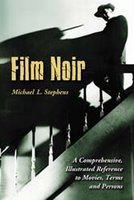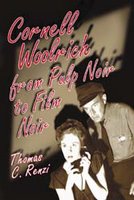Every month, I like to check in with my friends over at McFarland, the North Carolina publisher that specializes in highly-detailed, impressively-packaged pop-culture reference books.
Here's what's on tap for the house in February. I will be reviewing at least one of these texts (the Buffy the Vampire Slayer aesthetics book...) on the blog soon.
Here's what's on tap for the house in February. I will be reviewing at least one of these texts (the Buffy the Vampire Slayer aesthetics book...) on the blog soon.
 Television Networks: More than 750 American and Canadian Broadcasters and Cable Networks, by Dave Blevins:
Television Networks: More than 750 American and Canadian Broadcasters and Cable Networks, by Dave Blevins: From cartoons to cooking, science fiction to shopping, twenty-first century television seems to have a channel for every kind of programming. Today, a national networking capability is no longer necessary for a profitable television venture, and the old distinctions between “channel” (i.e., local programming) and “network” (national programming) have been erased. Television now offers hundreds of channels to a nationwide audience.This reference book offers a comprehensive listing of more than 750 channels and networks (the book uses whichever term the broadcaster has adopted) widely available in the United States and Canada. Programming genres vary widely and include news, sports, movies, music, religion, and more. The alphabetically arranged entries give channel name, contact information, launch date and first broadcast day. A brief description of broadcast structure and history is also included, and many entries also contain a brief list of major shows and their subject matter. An introduction to the work provides a concise history of the television industry, discussing major differences in the development of Canadian and American networks with special emphasis on the role of the government in each.
 Caped Crusaders 101: Composition Through Comic Books, by Jeffrey Kahan and Stanley Stewart:
Caped Crusaders 101: Composition Through Comic Books, by Jeffrey Kahan and Stanley Stewart:The comic-spawned Spider-Man franchise, despite its “pop” status, demonstrates important trends in literature. It raises numerous key questions for developing a better understanding of literary elements and devices. How, for example, do writers involved with the franchise reconcile divergent plotlines and characterizations that appear in multiple serials, and in a number of concurrent depictions of the hero in comic series, television series and films? Readers may be surprised to realize that Shakespeare grappled with similar topics in his Henry VI series, and, for instance, in the character Falstaff’s reemergence from death in The Merry Wives of Windsor.
This textbook inspires a greater appreciation for literature by studying important literary themes found in comics. By deconstructing comics, it raises critical thinking about literature, a crucial skill for understanding language and composition. Chapters discuss DC, Marvel and other comics’ varied attempts at portraying race, politics, economics, business ethics and democracy; responses to the Cold War and the events of September 11; and portrayals of prisons and capital punishment. Each chapter offers a series of questions that stimulate further reading, writing and discussion. Photographs are included as well.
 Prehistoric Humans in Film and Television, 581 Dramas, Comedies and Documentaries, 1905–2004, by Michael Klossner:
Prehistoric Humans in Film and Television, 581 Dramas, Comedies and Documentaries, 1905–2004, by Michael Klossner: From the early days of the movies, “cavemen” have been a popular subject for filmmakers—not surprisingly, since the birth of cinema occurred only a few decades after the earliest scientific studies of prehistoric man. Filmmakers, however, were not constrained by the emerging science; instead they most often took a comedic look at prehistory, a trend that continued throughout the 20th century. Prehistoric humans also populated adventure-fantasy films, with the original One Million B.C. (1940) leading the charge. Documentaries were also made, but it was not until the 1970s that accurate film accounts of prehistoric humans finally emerged.
This exhaustive work provides detailed accounts of 581 film and television productions that feature depictions of human prehistory. Included are dramas and comedies set in human prehistory; documentaries; and films and television shows in which prehistoric people somehow exist in historical periods—from the advent of civilization up to the present—or in extraterrestrial settings. Each entry includes full filmographic data, including year of release, running time, production personnel, cast information, and format. A description of each film provides background on the prehistoric elements. Contemporary critical commentary is included for many of the works.
 The Aesthetics of Culture in Buffy the Vampire Slayer by Matthew Pateman:
The Aesthetics of Culture in Buffy the Vampire Slayer by Matthew Pateman: On the TV screen as elsewhere, there is often more than meets the eye. For decades, television has offered not just entertainment, but observations—subtle and otherwise—on society. This book examines the cultural commentary contained in Buffy, the Vampire Slayer, a show that ran for seven seasons (1997–2003) and 144 episodes.
On the surface, Buffy is the marriage of a high school drama to gothic horror. This somewhat unusual vehicle is used to present, via the character of Buffy, fairly typical views of late 20th century culture-teenage problems; issues regarding a broken home; and the search for meaning and validation. In addition, subtler themes, such as cultural views of knowledge, ethnicity and history, are woven into the show’s critique of popular culture. Organized into two sections, this volume offers an in-depth examination of the show: first, through the lens of Buffy’s confrontation with culture, and second, from the complex perspectives of the individual characters. Issues such as values, ethical choices and the implications of one’s actions are discussed—without ever losing sight of the limitations of a medium that will always be dominated by financial concerns. The final chapter summarizes what Buffy has to say about today’s society. An appendix lists Buffy episodes in chronological order.
Extremely popular and prolific in the 1930s and 1940s, Cornell Woolrich still has diehard fans who thrive on his densely packed descriptions and his spellbinding premises. A contemporary of Hammett and Chandler, he competed with them for notoriety in the pulps and became the single most adapted writer for films of the noir period. Perhaps the most famous film adaptation of a Woolrich story is Alfred Hitchcock’s Rear Window (1954). Even today, his work is still onscreen; Michael Cristofer’s Original Sin (2001) is based on one of his tales.
This book offers a detailed analysis of many of Woolrich’s novels and short stories; examines films adapted from these works; and shows how Woolrich’s techniques and themes influenced the noir genre. Twenty-two stories and 30 films compose the bulk of the study, though many other additions of films noirs are also considered because of their relevance to Woolrich’s plots, themes, and characters. The introduction includes a biographical sketch of Woolrich and his relationship to the noir era, and the book is illustrated with stills from Woolrich’s noir classics.
This book offers a detailed analysis of many of Woolrich’s novels and short stories; examines films adapted from these works; and shows how Woolrich’s techniques and themes influenced the noir genre. Twenty-two stories and 30 films compose the bulk of the study, though many other additions of films noirs are also considered because of their relevance to Woolrich’s plots, themes, and characters. The introduction includes a biographical sketch of Woolrich and his relationship to the noir era, and the book is illustrated with stills from Woolrich’s noir classics.
Lee Marvin did not receive his first starring film role until he was 40, but in three short years—following the successes of Cat Ballou (for which he won the Academy Award as Best Actor), The Professionals and especially The Dirty Dozen—he was the most popular film actor in America. Marvin was a fascinating man, a loving husband and father, and one of the most natural, effective actors of his time.
This is a comprehensive reference of the Oscar-winning actor’s work. It includes biographical information on Marvin, an analysis of each of his 64 movies, chapters on his two television shows (M Squad and Lawbreaker), a listing of his television appearances, and a complete filmography (which includes video availability). The work is supplemented with dozens of photographs and film stills.
 Film Noir: A Comprehensive, Illustrated Reference to Movies, Terms and Persons, by Michael L. Stephens:
Film Noir: A Comprehensive, Illustrated Reference to Movies, Terms and Persons, by Michael L. Stephens: Film noir is a uniquely American genre that has stylistic links to the German expressionist cinema of the 1920s and thematic links to the hard-boiled crime fiction that emerged in the 1930s. Generally the milieu is urban and middle class, and the overall feel is one of repression and fatalism. Whether shot in black and white or color, the style reinforces the overall feel.
Films, directors, actors, producers, screenwriters, art directors, themes, plot devices and many other elements are contained in this encyclopedic reference work. Each movie entry includes full filmographic data (studio, running time, production and cast credits, and plot synopsis) along with an analysis of its place in the genre. Biographical entries focus on the person’s role in noir and provide a complete filmography of their film noir work. Terms are placed in the context of the genre and relevant examples from films are given.
Head over to McFarland to check out these and other great reference titles in the fields of film and television.









No comments:
Post a Comment